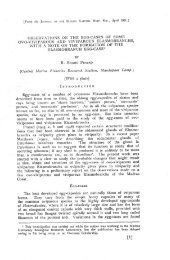PDF - Eprints@CMFRI
PDF - Eprints@CMFRI
PDF - Eprints@CMFRI
Create successful ePaper yourself
Turn your PDF publications into a flip-book with our unique Google optimized e-Paper software.
49<br />
II. Corallum essentially ramose with or without coalescence.<br />
7 . Branches fuse to form close-set inverted cone-shaped columns. At the sides of the columns<br />
papillae absent. On the top of the columns papillae squeeze out, prominent ones 2 to 3 mm<br />
thick and high . Calices 0.6 to 0.7 mm ... ... . ......... .. ........ . . . . . M. edwardsi<br />
8. Top of branches flattened . CoraLium short. Papillae form a labellate lower wall to the<br />
corallite. Calices 1 mm in diameter with 12 septa .... . ................ M. spongiosa<br />
9. A crowded cluster of stunted branches. Papillae inconspicuous, but form labellate lower<br />
wall to the corallite. Calices 0.5 to 0.7 mm, about 1 mm apart. The coral looks highly<br />
spinulose under the lens. . . . . . ....... .. . . . . .. . ... .. . .. .... .. ...... M. gracilis<br />
10. Arborescent. Papillae I to 2 mm , conical, either in close approximity to calyx or occupying<br />
the interstices. 2 to 3 of them may often fuse together. . .. ..... M. circumvallata<br />
C. Interstices with flame-like or grain-like frosted tubercles, sometimes in close approximity with calices.<br />
II . Encrusting, surface with close-set gibbosities. Tubercles short, rounded at the top. Calices<br />
0.6 to 0.8 mm , appear as projecting. . . .... . ..... . .... .. . ... .. . ..... . . M. stilosa<br />
12 . Foliaceous, surface with lobulations or a crowded cluster of coalescent branches. Tubercles<br />
often fuse to form low ridges. Calicular rim looks elevated . . . . . . . . .. M. ehrenbergi<br />
A. Foveolate species of Montipora .<br />
Corallum encrusting or submassive, calices surrounded by foveolations.<br />
Porites<br />
Mon tipora<br />
Manopora<br />
Montipora<br />
Montipora venosa (EHRENBERG), 1834<br />
(Plate 9, Figs. 4 . 5)<br />
ve1l0Sll 1834 , EHR ENBERG. 342 (Type locality : Red Su).<br />
ve"osa 1897, BERNARO, 69; pI. 32115 (synonymy).<br />
1906. v. MARENZElLER, 63;pl •. 21 166- 68; 23/66.- 68 •.<br />
1907, BEDOT. 274; pis. 461260- 262; 47/263- 266.<br />
1918. VAUGHAN . 153 ; pI. 6313.<br />
1925. HOFFMEISTER. SO, pI. 612., b.<br />
1952. CROSSLAND, 188 ; pis. 2615; 2715, 2817.<br />
1954. ROSSI. 45.<br />
1971 . LOVA & SLOBODKIN . 123 .<br />
1974, SCHEER & PllLAI, 27; pI. 1114.<br />
1980, HEAD, 148, 446.<br />
colei? 1954 , WELLS, 437 ; pI. 146/ 1. 2.<br />
planiusculD 1846. DANA. 507: pI. 47/ 3. 3a.<br />
1I11!'~c oSQ 1897. KLUN ZINGER 2, 35 ; pls. 5/ 14. 15 ; 6/ 10: t OI7(non LAMARCK).<br />
Corallum encrusting or hillocky. Calices about 1 mm (EC 470) or only 0.7 mm (EC 471), conspicuous,<br />
placed in deep funnel-like depressions formed of coenenchymal foveolations around the well cut-out wall .<br />
Individual papillae almost absent. They almost run together to form low ridges. Septa 12, primaries subequal<br />
fuse together to form a pseudo-columella. Surface of the corallum with gibbosities, rarely with<br />
conical projecting papillae. Surface unter the lens reveals a spiny reticulum.<br />
Material:<br />
Gulf of Suez:<br />
Gulf of Aqaba :<br />
orthern R. S.:<br />
T . Aviv<br />
T . Aviv<br />
Basel<br />
T. Aviv<br />
USNM<br />
HLM<br />
NS<br />
NS<br />
PW<br />
NS<br />
Wa<br />
EC<br />
8384, 8685 (Ras el Kanisa).<br />
1885 , 4976, 4996 (Dahab); 4836 (Ras Atantur).<br />
73 528 ? (Eilat, 6 m).<br />
1876 (Ras Muhammad).<br />
31 (Ghardaqa).<br />
470, 471 ( Ras Abu Suma); 60 (duplicate from KLUNZINGER as<br />
verrucosa) , 148 (Koseir).<br />
Di s t r ib uti o n : Red Sea ; Persian Gulf; Gulf of Mannar; Nicobar Islands; East Indies; Great Barrier<br />
Reef; Marshall Isi s.; Fiji ; Samoa; Cook Isis .<br />
Rem a r k s : BERNARD (1897) opined that the specimens described by KLUNZINGER from Red Sea<br />
under the names M. verrucosa and M. tIIberculosa are the same as M. venosa. However, a closer study of<br />
KL UNZINGER 's duplicate in HLM and of EHRENBERG 's type of venosa (No. 952 ) in Berlin Museum shows
















